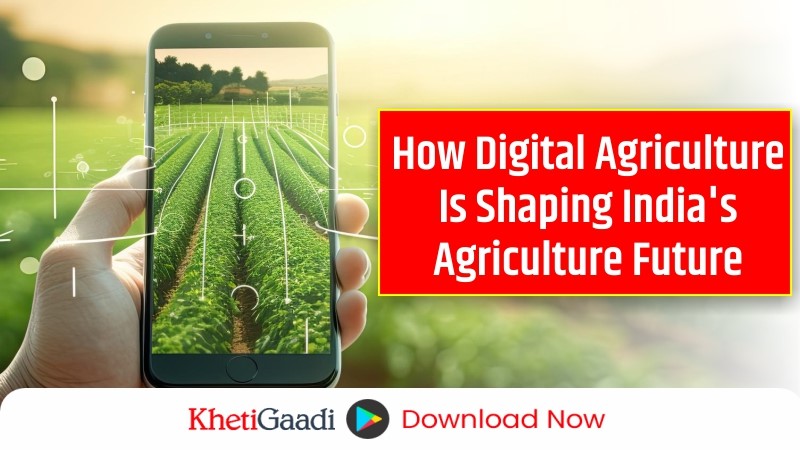Indian agriculture has been the backbone of the economy for centuries, employing millions and contributing significantly to the country’s GDP. However, challenges such as low productivity, resource inefficiency, and climate change have necessitated the transformation of the agricultural sector. Enter digital agriculture, a modern solution poised to revolutionize farming in India by integrating technology with traditional practices. As the government and private players push for a digital transformation in agriculture, the future of farming looks promising.
In this blog, we will explore the concept of digital agriculture, its future in India, its benefits, and the role of digital technologies in transforming the agricultural landscape.
What is Digital Agriculture?
Digital agriculture refers to the application of technology and data-driven approaches to enhance agricultural productivity, efficiency, and sustainability. It involves the use of digital tools and platforms such as sensors, drones, AI, and IoT (Internet of Things) to collect data, monitor farm conditions, and optimize farming operations. By enabling farmers to make informed decisions, digital agriculture helps them increase yields, reduce input costs, and ensure resource conservation.
The goal of digital agriculture is to transform traditional farming methods into more precision-based farming systems, where every aspect of farming, from soil health to crop harvesting, is managed using data analytics and automation.
Future of Digital Agriculture in India
The future of digital agriculture in India looks bright as the nation embraces new-age technologies to tackle agricultural challenges. With a population of over 1.3 billion, the need for a robust and efficient agricultural system is paramount. Here are some trends and predictions that shape the future of digital agriculture in India:
- Increased adoption of IoT and AI: With affordable internet and smartphone penetration, Indian farmers are increasingly adopting IoT devices and AI-driven solutions to monitor crop health, soil moisture, and weather conditions in real-time.
- Government initiatives: The Indian government is playing a critical role in promoting the digitalization of agriculture through schemes like PM-Kisan and the Digital India initiative. These initiatives aim to empower farmers with access to technology, market linkages, and financial support.
- Smart farming solutions: The demand for precision farming and smart irrigation systems will continue to rise as farmers aim to optimize input usage, conserve water, and increase productivity.
- Blockchain and supply chain transparency: Blockchain technology will ensure traceability and transparency in the agricultural supply chain, helping farmers get better prices for their produce while assuring consumers of the authenticity and quality of the products.
- Agri-tech startups: The rise of agri-tech startups like KhetiGaadi, DeHaat, and CropIn is fostering innovation in the sector, with these companies offering solutions ranging from tractor rentals and farm equipment to crop advisory services and data analytics.
Benefits of Digital Agriculture
The benefits of digital agriculture extend beyond just increased productivity. Here’s how digital agriculture can positively impact Indian farmers and the overall economy:
- Improved crop yields: By leveraging precision farming techniques, farmers can optimize the use of fertilizers, pesticides, and water, leading to higher yields and better-quality crops.
- Cost savings: Digital tools can reduce the need for excessive manual labor and inputs, helping farmers save on operational costs. For example, automated irrigation systems ensure water is only used when needed.
- Climate resilience: Digital agriculture can help farmers combat the effects of climate change by providing timely weather forecasts, pest alerts, and soil health updates, enabling them to make proactive decisions to protect their crops.
- Enhanced market access: Digital platforms can connect farmers with buyers, reducing the role of middlemen and helping farmers secure better prices for their produce.
- Sustainability: By promoting resource efficiency and reducing waste, digital agriculture contributes to the long-term sustainability of farming.
Role of Digital Technology in Agriculture
Digital technology is at the heart of the agricultural revolution. Below are some of the key technologies that are transforming the sector:
1. Internet of Things (IoT)
IoT in agriculture involves the use of sensors and devices to collect real-time data from the field. These sensors can monitor soil moisture, temperature, and humidity, allowing farmers to make informed decisions about irrigation, planting, and harvesting.
For example, IoT-enabled drip irrigation systems help conserve water by ensuring precise amounts of water are delivered to crops based on soil moisture levels.
2. Artificial Intelligence (AI) and Machine Learning (ML)
AI and ML are being widely used in digital agriculture to analyse vast amounts of data collected from the field. AI-powered platforms can provide farmers with predictive analytics, helping them anticipate crop diseases, forecast weather patterns, and optimize the use of fertilizers.
Startups like CropIn offer AI-based solutions that analyse satellite imagery and farm data to provide personalized crop advisory to farmers.
3. Drones and Satellites
Drones and satellite imaging are revolutionizing precision farming by providing aerial views of farmlands. Drones equipped with multispectral cameras can detect crop stress, pests, and diseases at an early stage. This allows farmers to address problems before they escalate, leading to healthier crops and better yields.
4. Blockchain
Blockchain in agriculture ensures transparency in the supply chain by recording every transaction related to the production and distribution of crops. With blockchain, farmers can create digital records of their produce, enabling buyers to trace the journey of food from the farm to the consumer’s plate.
Blockchain can also facilitate the creation of smart contracts, ensuring that farmers receive timely payments without the intervention of middlemen.
5. Mobile Applications
Mobile apps play a significant role in providing farmers with real-time information. Apps like KhetiGaadi offer services such as tractor rentals, farm machinery sales, and expert advice, all accessible via a smartphone. These apps are helping small and marginal farmers access modern agricultural tools and services, empowering them to boost productivity.
Challenges to the Adoption of Digital Agriculture in India
While the benefits of digital agriculture are clear, there are several challenges to widespread adoption in India:
- Limited digital literacy: Many Indian farmers, especially those in rural areas, are not familiar with digital tools and technologies. This limits their ability to adopt and fully benefit from digital agriculture.
- High cost of technology: While IoT devices, drones, and AI tools offer tremendous benefits, their initial setup cost can be prohibitive for smallholder farmers.
- Infrastructure gaps: Rural areas in India often suffer from poor internet connectivity and unreliable electricity, which are essential for the smooth functioning of digital tools in agriculture.
- Data privacy and security: The use of digital tools involves the collection and sharing of farm data. Ensuring the privacy and security of this data is a concern that needs to be addressed.
- Access to finance: Smallholder farmers often lack the financial resources to invest in modern farming technologies. Access to credit and financial services will be crucial in ensuring the widespread adoption of digital agriculture.
Government Support for Digital Agriculture
The Government of India has recognized the importance of digital agriculture in ensuring food security and sustainable growth in the agricultural sector. Various government schemes and initiatives are supporting the digitization of agriculture:
- Pradhan Mantri Fasal Bima Yojana (PMFBY): This crop insurance scheme aims to provide financial assistance to farmers in case of crop failure. The scheme’s digitized platform helps ensure quick processing of claims and disbursement of compensation.
- Digital India Initiative: The Digital India program is playing a significant role in bridging the digital divide by providing internet connectivity to rural areas. This is crucial for the adoption of digital tools in agriculture.
- eNAM (National Agriculture Market): The eNAM platform connects farmers with buyers across the country, enabling them to sell their produce online and secure better prices. The platform aims to create a unified national market for agricultural products.
- AgriStack: The government is working on developing AgriStack, a digital ecosystem that will provide farmers with personalized advisory services, financial assistance, and access to market linkages.
Conclusion
The future of Indian agriculture lies in embracing digital technologies. From AI and IoT to blockchain and drones, the integration of technology into farming practices will help Indian farmers overcome challenges such as low productivity, climate change, and resource inefficiency. With the support of the government, private sector, and agri-tech startups, digital agriculture will play a pivotal role in ensuring food security, increasing farmer incomes, and promoting sustainable farming practices in India. India is on the verge of a digital agricultural revolution, and those who adopt and embrace these changes will be the future leaders in farming.
Relevant Links
Tags




